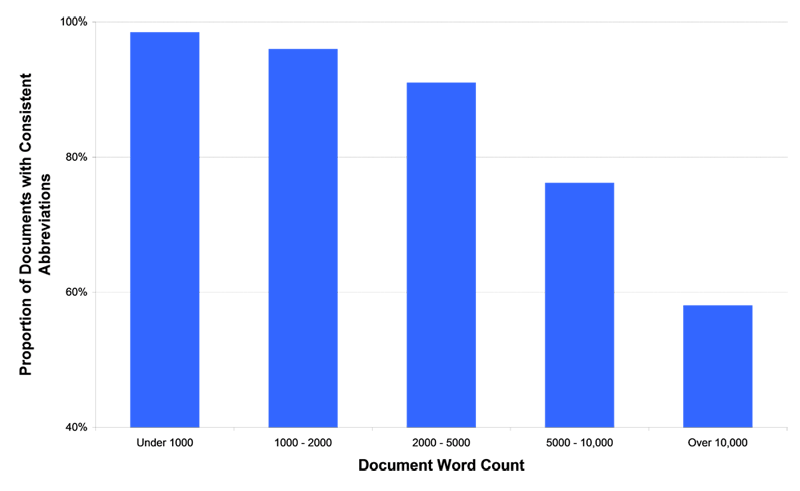Five Ways to Fail When Using Abbreviations and How to Avoid Them
20 September, 2011
We counted up the number of mistakes when using abbreviations in documents published online, and the results make depressing reading. So here are five things you can check so that your documents make the best impression and you make sure you get proposals, reports and articles accepted.
What We Tested
We used PerfectIt, Intelligent Editing's add-in for MS Word that locates undefined abbreviations, to check 3000 documents (randomly selected with the Google search term 'Final Report'). We split the results into smaller groups depending on the document size because the chance of making a mistake increases with larger documents.
Also note, there is a difference between acronyms, abbreviations and initialisms. For the purpose of simplicity, we use 'abbreviations' to refer to all three.
1. Define the Abbreviation the First Time You Use It
Not every abbreviation has to be defined. However, if you are going to define an abbreviation in the text, why would you wait till the second, third or fourth time to put the definition in? It sounds bad, and it is!
However, in the 1900 documents we looked at that were over 1500 words, more than a third included at least one abbreviation with this mistake. The worst had 19 abbreviations that came up in the text pages before their definitions.
2. Define the Abbreviation Once
If you decide to define an abbreviation, it should usually be defined only once. However, there are exceptions. In a report with sections or a book with chapters, you may decide to define the abbreviation at the start of each section/chapter.
Again, around a third of documents over 1500 words contained an abbreviation that was defined more than once. One document (that was under 20,000 words) had an abbreviation that was defined in 12 locations. We did a manual check and none of those related to any section or chapter headings. We spoke to top professional editor and director of the Communication Central conference, Ruth E. Thaler-Carter, who confirmed the finding: "Some house styles prefer to repeat the definition with each new section, but in the work I edit, repeated definitions often turn out to be unintentional, so they need to be fixed."
3. Refer to the Abbreviation Consistently
Is it 'NASA' or 'N.A.S.A.'? What about TFL or TfL? The best approach is to check their website to make sure that you use the correct version (they prefer NASA and TfL, respectively). If you're still not sure, check a style guide. The worst thing you can do is be inconsistent. Unfortunately, like most errors, the proportion of mistakes increases quickly with document size.
4. Just Use One Definition for Each Abbreviation
This is perhaps the most important thing to check because not doing it renders documents almost incomprehensible. ITT could mean Invitation to Tender or International Trade Team, so you must not abbreviate both names or phrases that way in the same document. Otherwise, the reader will struggle to figure out what your sentences even mean.
Fortunately, this error is quite rare. It only came up in thirty of the documents we tested. Nevertheless, it's worth checking carefully to make sure it doesn't creep into anything that you're working on.
5. Remember to Use the Abbreviation After Defining It
Abbreviations help keep your writing legible and concise. But what's the point in using them if you continue to write the word out in full after defining it? Unfortunately, it's all too common an error. We found that almost 40% of documents over 1500 words had at least one abbreviation treated this way.
These mistakes all add up. One document may have abbreviations appearing before definitions, abbreviations defined twice and abbreviations spelled out after being defined. When we add all the errors together, more than 60% of documents over 1500 words contain at least one mistake with abbreviations. On the bright side, that means you can easily make your documents better than the rest of the pack by paying extra attention to these mistakes.
How to Make Sure Your Documents Are Right
If you're checking text manually, it's worth reading through your document an extra time just to make sure there are no mistakes with abbreviations. This is time-consuming, but when you focus on one type of mistake, you're less likely to miss it. This is especially important in documents that have more than one author, because when documents are pasted together, it's easy to end up with both repetition and skipped definitions.
An even better approach is to use PerfectIt. PerfectIt offers a much faster way to check for these errors. Instead of reading all the way through your document again, PerfectIt can check it for you and in seconds locate any abbreviations that are:
- used before they are defined
- defined more than once
- written in two different ways
- written with two different definitions
- spelled out even after they are defined.
In addition, PerfectIt will find any abbreviations that have not been defined and can automatically generate a Table of Abbreviations. That can make a big difference, because it saves time checking and makes documents easier to read. As a result, with PerfectIt, your proposals, articles and reports are more likely to be accepted. PerfectIt is free to try, so download it now.





